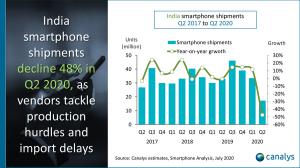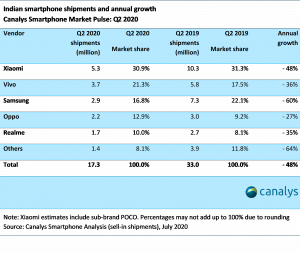India smartphone market shrinks by nearly 50% in Q2 2020
Smartphone shipments in India fell 48% in Q2 2020, to 17.3 million units as the country faced an unprecedented shutdown of its economy due to COVID-19..
As local production suffered through the early stages of Q2, vendors like Xiaomi and Oppo imported smartphones to meet pent-up demand. “It’s been a rocky road to recovery for the smartphone market in India,” said Canalys Analyst Madhumita Chaudhary. “While vendors witnessed a crest in sales as soon as markets opened, production facilities struggled with staffing shortages on top of new regulations around manufacturing, resulting in lower production output. The fluidity of the lockdown situation across India has had a deep-rooted effect on vendors’ go-to-market strategies. Xiaomi and Vivo have undertaken an O2O (offline-to-online) strategy to support their massive offline network. Online channels, too, while seeing a positive effect of the pandemic on market share, have seen sales decline considerably.”
India is also battling floods in parts of Eastern India, and a stand-off with China in the Northern borders. “Luck is not on the side of the Chinese vendors,” says Canalys Research Analyst Adwait Mardikar. “There has been public anger directed towards China. The combinations of this and the recently announced ‘Aatmanirbhar’ (self-sufficient) initiatives by the government have pushed Chinese smartphone vendors into the eye of the public storm.” Canalys estimates that over 96% of all smartphones sold in India in 2019 were manufactured/assembled locally. “Vendors are driving the message of ‘Made in India’ to consumers and are eager to position their brand as ‘India-first.’ Despite the sentiment, the effect on Xiaomi, Oppo, Vivo and Realme is likely to be minimal, as alternatives by Samsung, Nokia, or even Apple are hardly price-competitive,” added Mardikar.
Apple was the least impacted among the top-10 vendors as shipments fell just 20% year-on-year to just over 250,000 in Q2 2020. The vendor has recently announced its plans to diversify its supply chain and is pushing its major partners Foxconn and Wistron to increase its investments in India.
“The transition to 5G is the next big opportunity, and Jio’s announcement of readiness to deploy 5G, as soon as spectrum is made available, has provided a ray of hope to most vendors who have been beaten by the current pandemic,” added Chaudhary.
Rushabh Doshi
Canalys
+91 99728 54174
email us here
Legal Disclaimer:
EIN Presswire provides this news content "as is" without warranty of any kind. We do not accept any responsibility or liability for the accuracy, content, images, videos, licenses, completeness, legality, or reliability of the information contained in this article. If you have any complaints or copyright issues related to this article, kindly contact the author above.


